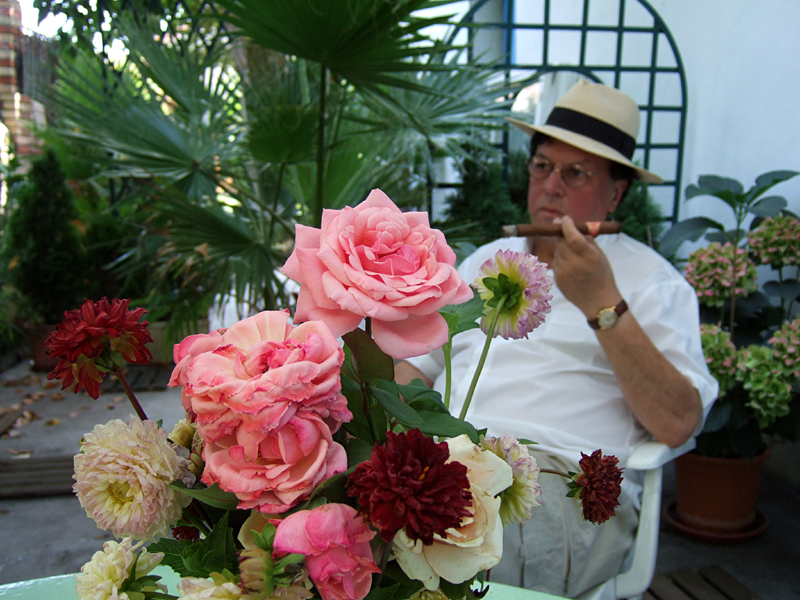Biography
|
|
His painting style
Bernard DUVERT'S style emerges from the characters he paints. It expresses a therapeutic energy extracted from highly coloured caricatures, manifesting in broad and powerful movements of the brush, and instinctive, spontaneous gestures. It releases rather than represses the impulse.
The drawing is distinguished by its elongated shapes, shapes that take after the image of the cypress, which he observed during a stay in Provence. Following from that, there is in those longer lines something phallic, a motif imbued with obsession and determination, so that we can say that it is the instinct of the gesture that creates the subject, leading to a highly equivocal completion.
The choice of predominantly “religious” subjects does not mean that he conforms to the pattern of what has been done in the field of Sacred Art, because he rather gives new direction to sacred themes, controverting beliefs and dogmatic certainty. His style reveals a mystic element born from the ambiguity of his relationship to God and Man.
Some have seen in his paintings a kind of continuity with El Greco, a resemblance to this artist's method of transfiguration, similarly beginning with a Christ or a saint’s life, and leading us to an almost total delirium. This transformism which elongates everything, also presents us with the silhouette and with the earth itself, reinventing a grammar of color. But there is more in common here with Manessier, or Rouault, by virtue of the stained glass effects and the contours.
There is also an exaltation, an immediacy coupled with the divine and its voluptuousness, and everything is inspired with the feeling of the Sublime.
The understanding of his writing is only possible in the context of current avant-garde movements, which claim with him the right to reverse the value relation between religion and society, Faith and the Sacred.
His Orientation
After distancing himself from pure expressionism, at least in form if not in spirit, Duvert feels that he is taking his field of vision on an iconoclastic quest, where derision, sometimes close to caricature, succeeds while destroying the sacred aura of his subject, and brings us closer to the world of primitive symbols and archetypes. In looking into the thickness of the paint, he manages to unravel the mystery of luminous matter without revealing with what supernatural means it is executed.
The snapshot, the immediacy of gesture with which he works, can achieve a more vivid expression than a process of reflection. The ideas which flow make a sudden impact with other things that do no necessarily have consistency between them, but have the advantage of creating a mystical reconstruction of the subject, joined together with therapeutic elements.
In fact, his view of the religious world of the sacred as he had once to confront it as a priest, as fascinating as these images might have been, is now ruptured by a creative and illuminated consciousness.
Pushed on by the new debate on Sacred and Religious Art, which he places in his work at the centre of a contemporary reality in search of new symbols, he feels the need to find in the flux new critical theologies, new forms.
Duvert thus begins to form his current Critique, which in itself constitutes a big part of his work.
This trend is evident since 1987, his most expressionist period, and is re-iterated in the transformation of his current writing style.

Copyright (c) 2006 Bernard Duvert. Tous droits réservés.
 Bernard Duvert was born in 1951 in Paris and died in 2022 in Toulouse. He studied theology and philosophy from 1971. He has always endeavoured to reconcile his love of painting, which has been a part of his life from childhood, with his religious commitment. He was ordained a priest in 1979 and becomes chaplain of the artists at Capitole Theater in Toulouse. His painting finds its expression in a critical figuring of religious scenes. His meeting with Bengt Lindström in 1988 marked a turn towards expressionism. When he emancipated himself from the influence of the great Swedish artist, he developed a free vision of sacred art through vertical writing, since 1995, inspired by processions of cypress trees, brought into relief by colours like in the art of stained glass. As a painter, poet and writer, his work in writing as in his painting centres on eroticism in the sacred. His books have been published since 1999 by Editions de la Différence and then by Editions Artys. Bernard Duvert founded the
Bernard Duvert was born in 1951 in Paris and died in 2022 in Toulouse. He studied theology and philosophy from 1971. He has always endeavoured to reconcile his love of painting, which has been a part of his life from childhood, with his religious commitment. He was ordained a priest in 1979 and becomes chaplain of the artists at Capitole Theater in Toulouse. His painting finds its expression in a critical figuring of religious scenes. His meeting with Bengt Lindström in 1988 marked a turn towards expressionism. When he emancipated himself from the influence of the great Swedish artist, he developed a free vision of sacred art through vertical writing, since 1995, inspired by processions of cypress trees, brought into relief by colours like in the art of stained glass. As a painter, poet and writer, his work in writing as in his painting centres on eroticism in the sacred. His books have been published since 1999 by Editions de la Différence and then by Editions Artys. Bernard Duvert founded the 